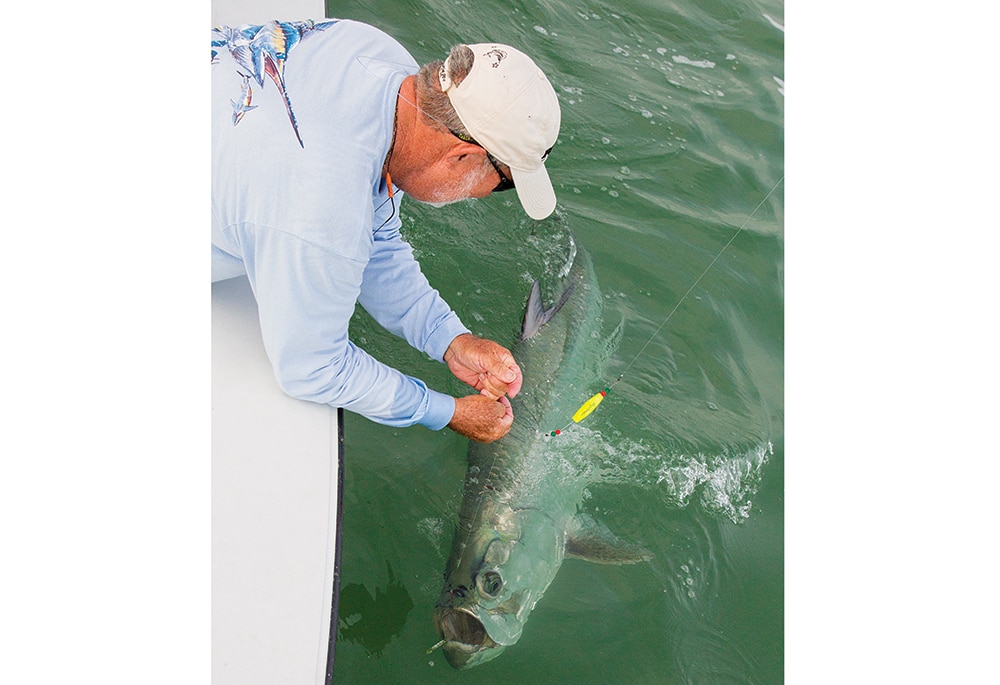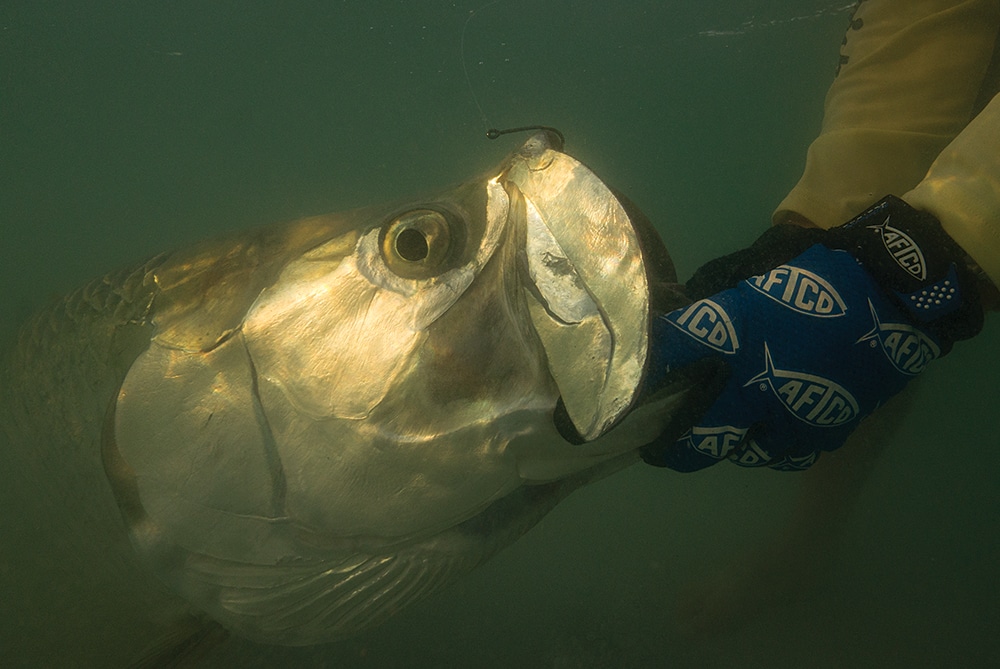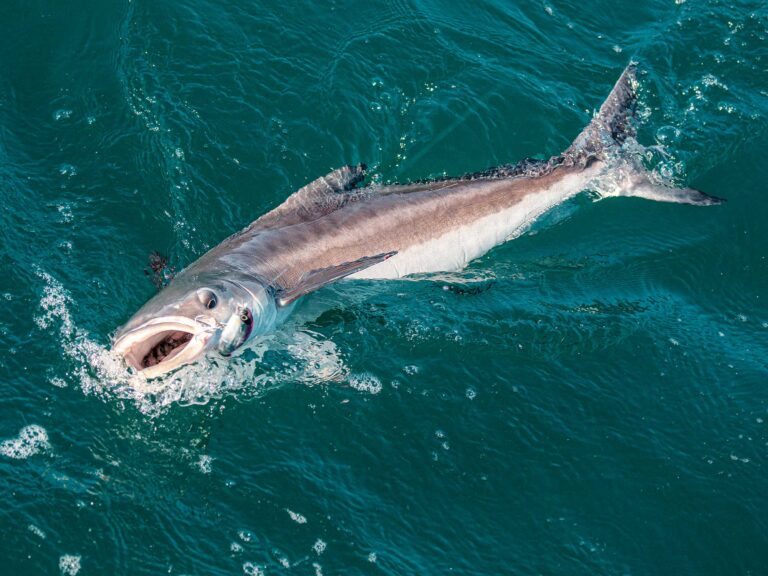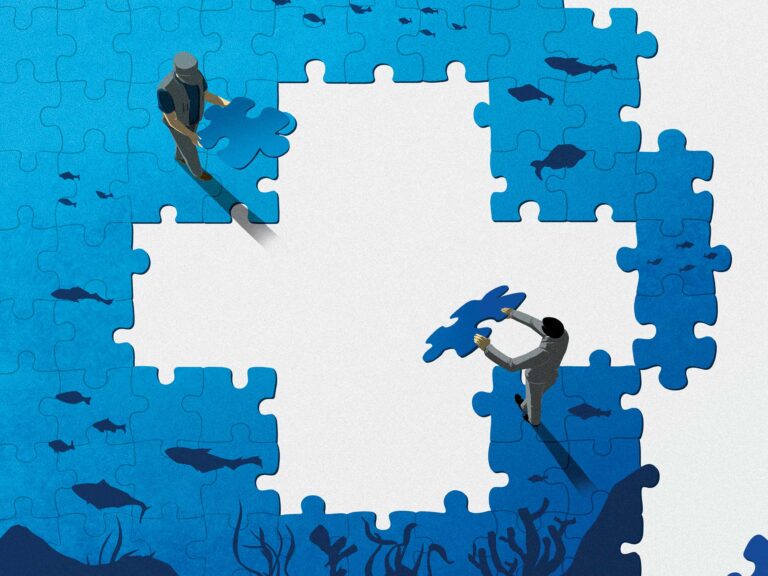
Tarpon
_Key West’s Tarpon Show: Of the many distractions available to visitors in Key West, fishing always comes up as one of the most popular. That’s because Key West offers more variety in terms of saltwater-fish species than just about anywhere else in the United States. Of all the fish available there, many anglers prefer tarpon above all others. These magnificent fish have much to offer, including strength, beauty, agility and, most of the time, a willingness to bite. Tarpon fishing can be addictive. _
One of the most pleasant fishing trips I’ve ever had in the Florida Keys came about quite by accident. Several friends and I had chartered Capt. Robert “R.T.” Trosset for a weekend of offshore fishing out of Key West, and as I drove down Friday afternoon from Miami, I gave Trosset a call to see how his day had been. It was just after daylight saving time had begun, and as it turned out, his charter for the day had decided to return to the dock early, so he planned to use the free time — and the bonus daylight — to do a bit of evening tarpon fishing. He asked if I’d like to ride along. Let me think: Yes!
I pulled up to Trosset’s dock on Big Coppitt Key at about 5 p.m., and we loaded spinning rods rigged with 40-pound braid into his skiff. Within 10 minutes of his dock are half a dozen channels that hold tarpon from February through July. A short run brought us to a calm channel with a falling tide on the ocean side of US1, where we dropped anchor.
Drive ’Em Crazy
Trosset selected a crab from the livewell, hooked it through a point of the shell and cast it upcurrent. The rig was simple: five feet of 60-pound fluorocarbon leader tied to a D.O.A. float, followed by three more feet of 60-pound leader tied to a 7/0 circle hook. The float is an essential element in this type of fishing. “It’s the same float you’d use for trout and redfish,” says Trosset. “Without it, the crab would head to the bottom and burrow in.”
Suspended by the float, the crab drifts at the tarpon’s eye level, carried by the current. The float helps you keep tabs on the drift as well.
“Let the crab drift slowly back in the current,” Trosset explained, as he handed me the rod and began rigging another for himself. “Stop it every 30 seconds or so, and let it swim to the surface, and then free-spool it again so the crab tries to swim down. That drives the tarpon crazy.”
Trosset’s crab hadn’t drifted 50 feet before he was tight to a fish, and it was huge. He vigorously explained that I was the mate now, and I’d better throw the anchor and start the motor, because his fish was more than 100 yards away with no sign of slowing down. We estimated that first fish at 150 pounds and, typically, as soon as we got the engine going and began to gain some line, it went into another series of jumps and spit the hook. No matter — the fun part was over, and the work was about to begin, so we were pleased with the encounter and the abrupt ending.
Good As It Gets
We had barely returned to the anchor and set out two more baits when another tarpon was in the air. This one was around 100 pounds and a bit easier to control. We chased it around a few markers until it was in optimum photo range, then set about letting it jump for the camera. The soft light of the setting sun cast a golden hue on everything, adding to the beauty of the scene: calm seas, a light breeze, and jumping tarpon against a magnificent Key West sunset. It doesn’t get any better than that.
Over the next hour, we had three more tarpon in the air. Strikes came subtlety during the drift or exploded when the crab hung in the current, and the fish were always big. The size of the crab alone discouraged anything under 75 pounds from trying to consume it, and the heavy spinning tackle kept the fight reasonable. In two hours, we jumped nine tarpon and landed three of them, all more than 100 pounds. By 8:15, we were in Babalu’s restaurant ordering dinner.
Simple Drill
Any number of channels from Big Pine Key to Key West Harbor hold tarpon in the evenings. An outgoing tide is probably best, and the narrower the channel, the easier it will be to spot the fish. If there’s a bend or a deep hole, anchor up-current about 50 yards, and let the bait drift back into it. Almost any channel that has good outgoing water flow will do, so long as water depth is between four and 20 feet, says Trosset. The narrow channels seem to be easier to locate fish in, and look for deeper holes in the channels too.
If you notice tarpon rolling in a specific area, that’s where you should fish. Be sure to have a buoy on your anchor line, because you’ll need to unsnap quickly and chase every fish you hook. They simply head for the ocean, and they are really fast!
These days, a sunset tarpon trip is definitely on my charter menu. I’m sure there are days when the tarpon don’t show up, but on every trip I’ve made, we’ve jumped up to a dozen fish in a few hours on days when the flats guides — who knock off around 4 p.m. — were getting only a few shots in a full day’s fishing. If you really want to catch a 100-pound tarpon, an evening excursion is the way to do it.
Florida Keys Tackle Box
Live bait is the most productive way to fish, and big crabs are preferred because the jacks, snappers and junk fish leave them alone. The best-size crabs are hard to find, and you might have to catch your own if the local tackle shops don’t have any big ones. Smaller permit-size crabs are acceptable if that’s all you can get. Live mullet or pinfish also work well, but your hookup ratio will be 1-to-3 with crabs and 1-to-8 with mullet. Big shrimp are way down the list, because everything that swims in the channel eats them. You’re almost better off casting a big Gulp! jerk bait or some other form of super-size soft plastic.
If you are addicted to fly-fishing, dredging with a slow-sinking line and a big black-and-purple fly can be effective.
Rods: Heavy, 7-foot Van Staal spinning rods with a light tip, or equivalent
Reels: FinNor 4500 or 5500 reels or equivalent, with smooth, powerful drags
Line: 30- to 50-pound braid
Bait: The bait of choice is a crab about the size of your palm, followed by smaller crabs and live mullet.
Rigs: Nine feet of 60-pound fluoro leader, with a D.O.A. Clacker float inserted about three feet up the leader from the hook to keep the crab off the bottom, and a 6/O or 7/O Mustad 39950NP-BN circle hook. Hook should be sized to the size of the crab/bait. If fish get picky or the water is clear, drop to 40-pound fluoro leader and a 6/O hook.
Keys Tarpon Planner
The three-hour window before dark is ideal — you’ll hook lots of fish after dark too, but you can’t see anything, just hear a lot of splashing. Once you’re anchored up, cast the crab up-current and let it drift back with the tide. Every 30 seconds, stop the drift and let the crab rise to the surface. Let it hang for 30 seconds, then go back to free-spool for 30 seconds, and repeat till you’ve covered all the prime water. A crab on the surface drives the tarpon crazy, but you can’t let it hang there forever; no crab swims that well.
The strikes can come at any time, and they are usually explosive. When it comes, drop back, then point the rod right at the fish, and simply start reeling. Circle hooks are designed to be swallowed, and then pulled back out to catch in the corner of the jaw. If you raise the rod to set the hook, you’ll just be wasting a hard-to-come-by crab.
What: Giant tarpon
Where: Lower Keys
When: Late afternoon until dark, February through July
Who: This is a fishery anyone can enjoy on his own with a little bit of exploration. To shorten your learning curve go with a pro:
Capt. Robert “R.T.” Trosset, 305-797-5693, spindriftfishing.com
Capt. Chris Trosset, 305-747-4719, christrosset.com
Capt. Jared Cyr, 305-797-0566














